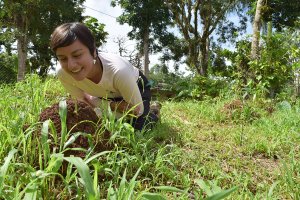Presented By: Ecology and Evolutionary Biology
EEB thesis defense: The role of Pseudacteon spp. on the coexistence between invasive Solenopsis invicta and Wasmannia auropunctata on Puerto Rican coffee farms
Jennifer Flores, U-M EEB Graduate Student

Please see your email or contact eeb.gradcoord@umich.edu at least two hours prior to the event for the link and passcode.
Abstract
Agricultural settings such as coffee farms function as novel ecosystems, having multiple species that have not interacted with each other at any other point in history and constant human intervention. The ant community on Puerto Rican coffee farms has experienced this novelty, with the most dominant ant species being invasive. S. invicta and W. auropunctata both cause economic loss during the coffee harvest, due to their powerful stings targeting farmworkers while they are in the coffee. W. auropunctata is the most dominant across many farms, while S. invicta is the second most dominant. W. auropunctata is behaviorally passive in comparison to S. invicta, which is much more aggressive when encountering other ants. However, two different Puerto Rican farms, Gran Batey and Casa Pueblo, are seeing two different stages of dominance between W. auropunctata and S. invicta. Phorid flies (Pseudacteon spp.) may be responsible for this difference and for S. invicta not being the dominant ant. Phorid flies are parasitoids that specialize on S. invicta, limiting their competitive abilities in their native ranges. We hypothesize that phorid flies may be mediating the coexistence of the two species, ultimately allowing W. auropunctata to be the dominant ant. In this study, we conduct a disturbance survey and foraging survey to assess when and where phorids are most active and compare this activity between Gran Batey and Casa Pueblo. We find that phorid fly activity increases throughout the day, with the most activity at 12 p.m. Additionally, we find that Casa Pueblo, who is experiencing W. auropunctata dominance, has more phorid flies and more phorid fly attacks in comparison to Gran Batey which is currently experiencing S. invicta dominance. We conclude that phorid flies cause trait-mediated indirect effects (TMIE) on S. invicta, allowing them to coexist with the rest of the ant community on Puerto Rican coffee farms.
Abstract
Agricultural settings such as coffee farms function as novel ecosystems, having multiple species that have not interacted with each other at any other point in history and constant human intervention. The ant community on Puerto Rican coffee farms has experienced this novelty, with the most dominant ant species being invasive. S. invicta and W. auropunctata both cause economic loss during the coffee harvest, due to their powerful stings targeting farmworkers while they are in the coffee. W. auropunctata is the most dominant across many farms, while S. invicta is the second most dominant. W. auropunctata is behaviorally passive in comparison to S. invicta, which is much more aggressive when encountering other ants. However, two different Puerto Rican farms, Gran Batey and Casa Pueblo, are seeing two different stages of dominance between W. auropunctata and S. invicta. Phorid flies (Pseudacteon spp.) may be responsible for this difference and for S. invicta not being the dominant ant. Phorid flies are parasitoids that specialize on S. invicta, limiting their competitive abilities in their native ranges. We hypothesize that phorid flies may be mediating the coexistence of the two species, ultimately allowing W. auropunctata to be the dominant ant. In this study, we conduct a disturbance survey and foraging survey to assess when and where phorids are most active and compare this activity between Gran Batey and Casa Pueblo. We find that phorid fly activity increases throughout the day, with the most activity at 12 p.m. Additionally, we find that Casa Pueblo, who is experiencing W. auropunctata dominance, has more phorid flies and more phorid fly attacks in comparison to Gran Batey which is currently experiencing S. invicta dominance. We conclude that phorid flies cause trait-mediated indirect effects (TMIE) on S. invicta, allowing them to coexist with the rest of the ant community on Puerto Rican coffee farms.